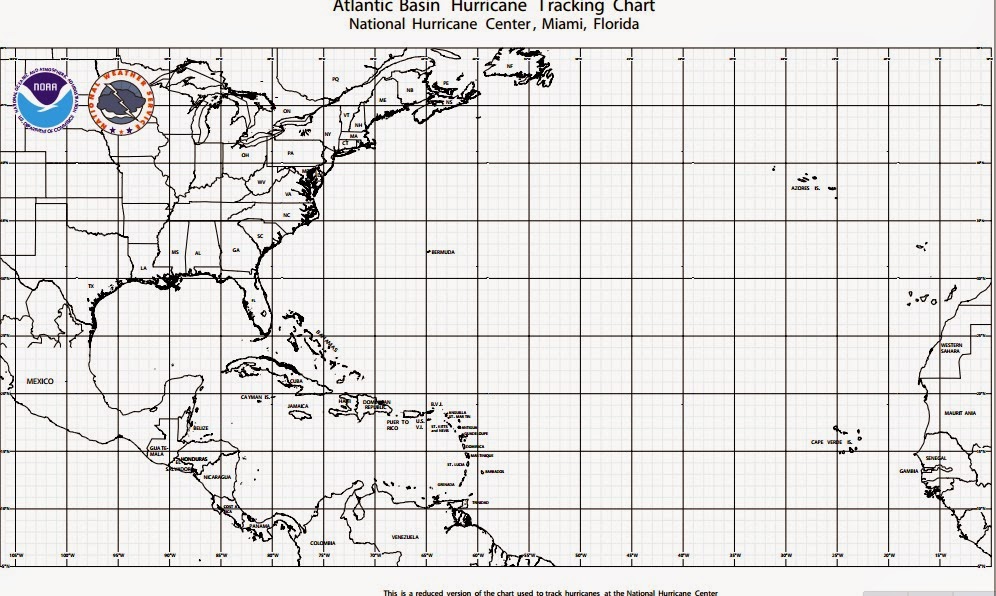Lab #8 – Tracking Hurricanes
Hurricanes are classified according to the Saffir-Simpson
Scale, which categorizes the storms from one to five depending on sustained
wind speed, height of storm surge, and extent of damage. Some of the specifics
for each hurricane category are listed in Table 1. The National Weather Service
issues a hurricane watch when there is a threat of hurricane conditions within
24 to 36 hours. They issue a hurricane warning if hurricane conditions are
expected within 24 hours.
Problem
How are
hurricanes tracked?
Hypothesis
Materials
Pencil
Procedure
Part
a—Historical Hurricanes
- Familiarize
yourself with the classifications of hurricanes according to the
Saffir-Simpson Scale in Table 1.
- Read
about some major hurricanes of the past, which are described in the Data
and Observations section, and watch the 2012 Hurricane Sandy Video.
- Use
the Saffir-Simpson Scale to classify each of the historical hurricanes
described in the Data and Observations section. Write the category number
in the space provided next to each description.
Part
B—Hurricane Tracking
- Use
the data in Table 2 to plot the course of a hurricane. Start by plotting
the storm's location on Day 1 on the Hurricane Tracking Chart in Figure
1.Mark the hurricane's location with a dot, and label it as Day 1.
- Considering
only wind speed, classify the storm as a tropical storm or a hurricane. If
the wind speed is less than 119 km/h, consider it a tropical storm. If the
wind speed is 119 km/h or more, use the Saffir-Simpson Scale to decide
what category describes the hurricane on this day. Write your observations
in Table 2.
- Plot
the storm's location at Day 2, label the dot, and connect the two dots
with a straight line. Classify the storm as described in step 2.
- Consider
that you are a forecaster with the National Weather Service. You must
issue a hurricane warning to any land 24 hours before the center of a
hurricane passes over it. Decide if you should issue a warning on Day 2.
If yes, what areas would you warn? Write your observations in Table 2.
- Repeat
steps 3 and 4 for the storm's duration.
Part A
Data and Observations
8. ____ Hurricane
Irene, made its final landfall in Brooklyn,
New York City in 2011. Throughout its
path, Irene caused widespread destruction and at least 56 deaths. Damage estimates
throughout the United States are estimated near $15.6 billion. Its highest winds reached 120
mph (195 km/h).
9.
____ Hurricane Sandy
affected 24 states in
the U.S., including the entire eastern
seaboard from Florida to Maine and west across the Appalachian Mountains to Michigan and Wisconsin, with particularly severe damage in New Jersey and New York. Its storm surge hit New York City on October 29, 2012, flooding streets, tunnels and subway
lines and cutting power in and around the city. Damage in the United States
amounted to $65 billion. Its
highest winds reached 115 mph (185 km/h).
|
Table
1
Saffir-Simpson Hurricane Scale
|
||
Category
|
Wind Speed (km/h)
|
Effects
|
One
|
119-153
|
No real damage
|
Two
|
154-177
|
Some roof and window damage
|
Three
|
178-209
|
Some structural damage to small residences; mobile homes
destroyed
|
Four
|
210-249
|
Extensive building failures
|
Five
|
greater than 249
|
Complete roof failure on buildings; some complete building
failures
|
Part B
Day
|
Latitude (°N)
|
Longitude (°W)
|
Wind speed (km/h)
|
Type of Storm
|
Issue warning? Where?
|
1
|
15
|
47
|
56
|
||
2
|
17
|
53
|
80
|
||
3
|
18
|
57
|
112
|
||
4
|
21
|
60
|
144
|
||
5
|
23
|
64
|
160
|
||
6
|
23
|
69
|
232
|
||
7
|
25
|
74
|
216
|
||
8
|
27
|
78
|
216
|
||
9
|
32
|
79
|
168
|
||
10
|
41
|
74
|
96
|
||
11
|
45
|
67
|
72
|
||
12
|
48
|
56
|
64
|
Analysis
- Which
of the storms described in Part A were category five hurricanes?
- What
information did you use to classify each of the storms?
- Describe
the conditions that led you to issue a hurricane warning.
- Did
the center of the storm pass over the areas to which you decided to issue
warnings?
- When
did the hurricane tracked in Part B reach the status of a category three
hurricane? (Hint: The data presented in Table 3 shows one
measurement for each day of the storm.)
- Did
the hurricane that you tracked in Part B show characteristics of every
category described by the Saffir-Simpson scale?
7.
The formation of a hurricane depends
on what three factors?
8.
Reflect: A hurricane starts out as a
low pressure system, why is this so? Why
would a high pressure area not turn into a hurricane?
______________________________________________________________________
Conclusion
What was your problem?
|
Restate your hypothesis. Was it right? wrong? why or why not?
|
What did you learn in this lab?
|
What did you like about this lab?
|
What were some challenges you had to deal with?
|
What could you do next with this problem? What other tests could you perform?
|
Write down any other additional thoughts, observations, inferences, etc.
|

Nice blog.The useful custom essay writing service guide is providing the great guidance to the college students.
ReplyDeleteWhat does more damage-- A tornado or a hurricane?
ReplyDeletepublic adjuster miami